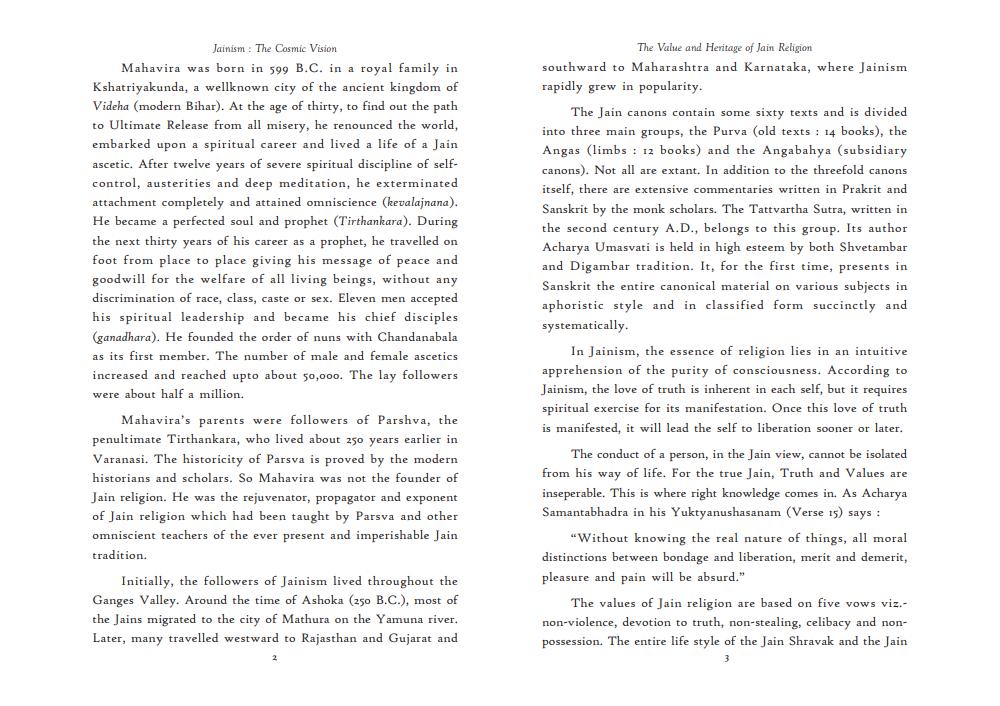Book Title: Jainism The Cosmic Vision Author(s): Kumarpal Desai Publisher: Mahavir Foundation View full book textPage 8
________________ Jainism: The Cosmic Vision Mahavira was born in 599 B.C. in a royal family in Kshatriyakunda, a wellknown city of the ancient kingdom of Videha (modern Bihar). At the age of thirty, to find out the path to Ultimate Release from all misery, he renounced the world, embarked upon a spiritual career and lived a life of a Jain ascetic. After twelve years of severe spiritual discipline of selfcontrol, austerities and deep meditation, he exterminated attachment completely and attained omniscience (kevalajnana). He became a perfected soul and prophet (Tirthankara). During the next thirty years of his career as a prophet, he travelled on foot from place to place giving his message of peace and goodwill for the welfare of all living beings, without any discrimination of race, class, caste or sex. Eleven men accepted his spiritual leadership and became his chief disciples (ganadhara). He founded the order of nuns with Chandanabala as its first member. The number of male and female asceties increased and reached upto about 50,000. The lay followers were about half a million. Mahavira's parents were followers of Parshva, the penultimate Tirthankara, who lived about 250 years earlier in Varanasi. The historicity of Parsva is proved by the modern historians and scholars. So Mahavira was not the founder of Jain religion. He was the rejuvenator, propagator and exponent of Jain religion which had been taught by Parsva and other omniscient teachers of the ever present and imperishable Jain tradition. Initially, the followers of Jainism lived throughout the Ganges Valley. Around the time of Ashoka (250 B.C.), most of the Jains migrated to the city of Mathura on the Yamuna river. Later, many travelled westward to Rajasthan and Gujarat and The Value and Heritage of Jain Religion southward to Maharashtra and Karnataka, where Jainism rapidly grew in popularity. The Jain canons contain some sixty texts and is divided into three main groups, the Purva (old texts : 14 books), the Angas (limbs : 12 books) and the Angabahya (subsidiary canons). Not all are extant. In addition to the threefold canons itself, there are extensive commentaries written in Prakrit and Sanskrit by the monk scholars. The Tattvartha Sutra, written in the second century A.D., belongs to this group. Its author Acharya Umasvati is held in high esteem by both Shvetambar and Digambar tradition. It, for the first time, presents in Sanskrit the entire canonical material on various subjects in aphoristic style and in classified form succinctly and systematically. In Jainism, the essence of religion lies in an intuitive apprehension of the purity of consciousness. According to Jainism, the love of truth is inherent in each self, but it requires spiritual exercise for its manifestation. Once this love of truth is manifested, it will lead the self to liberation sooner or later. The conduct of a person, in the Jain view, cannot be isolated from his way of life. For the true Jain, Truth and Values are inseperable. This is where right knowledge comes in. As Acharya Samantabhadra in his Yuktyanushasanam (Verse 15) says: "Without knowing the real nature of things, all moral distinctions between bondage and liberation, merit and demerit, pleasure and pain will be absurd." The values of Jain religion are based on five vows viz.non-violence, devotion to truth, non-stealing, celibacy and nonpossession. The entire life style of the Jain Shravak and the JainPage Navigation
1 ... 6 7 8 9 10 11 12 13 14 15 16 17 18 19 20 21 22 23 24 25 26 27 28 29 30 31 32 33 34 35 36 37 38 39 40 41 42 43 44 45 46 47 48 49 50 51 52 53 54 55 56 57 58 59 60 61 62 63 64 65 66 67 68 69 70 71 72 73 74 75 76 77 78 79 80 81 82 ... 137
